Life Processes
Class-10-CBSE-NCERT-Science-Chapter-5
Notes-Part-2
Topics to be learn : Part-2
|
Transportation :
Transportation in human beings :
- The transport system (called circulatory system) in human beings consists of heart, blood and blood vessels.
Functions of components of circulatory system:
(i) Blood:
- Blood is a fluid connective tissue, it consists of a fluid medium known as plasma in which different types of cells such as white blood cells and red blood cells are suspended.
- Plasma transports food, carbon dioxide and nitrogenous wastes (urea and uric acid) in dissolved form.
- Red blood cells transport oxygen.
- Blood also transports many other substances like hormones, salts, etc.
- Platelets present in the blood stop bleeding by forming blood clots.
(ii) Heart:
- The heart is a muscular organ which is as big as our fist.
- Heart is a pumping organ to push blood around the body.
- It receives deoxygenated blood from the body parts and pumps it to lungs for its oxygenation.
- It receives purified blood from lungs and pumps it around the body.
(iii) Blood vessels:
- Blood vessels form a closed network of tubes to reach all the tissues.
- Thus, the blood pushed by the heart flows in the blood vessels (arteries) and also comes back to the heart in the blood vessels (veins).
(1) Blood :
- Blood is a connective tissue.
- It has pale-coloured fluid matrix called plasma. Plasma contains water and proteins.
- Blood flows in blood vessels and does not come in contact with body tissues.
- Blood flows from heart to body organs and returns to heart.
Components of blood and their functions:
In the plasma of blood the following three types of cells are found:
(i) Red blood cells/corpuscles or Erythrocytes :
- Red blood cells/corpuscles or erythrocytes are spherical, disc-shaped. Human
- RBCs are biconcave and are devoid of nucleus.
- Their number is about 5 million per cubic mm of blood.
- Their red colour is due to the presence of a pigment called haemoglobin.
- Main function of RBCs is to transport oxygen with the help of haemoglobin.
(ii) White blood cells/corpuscles or Leucocytes :
- White blood cells/corpuscles or leucocytes do not have a definite shape but possess a nucleus. These are bigger than RBCs and are of five types.
- Main function of leucocytes is to protect the body from microorganisms and provide immunity to body.
- White blood corpuscles are called soldiers of the body because: (i) they protect the body from infections. (ii) they are capable of squeezing out of capillaries to eat up foreign matter. (iii) they also manufacture antibodies which are responsible for immunity.
(iii) Blood platelets or Thrombocytes :
- Blood platelets or thrombocytes are small bodies numbering about 2,00,000 to 4,00,000 per cubic millimeter of blood.
- They perform an important function of forming a clot on blood vessel in case of an injury and thus prevent excess flow of blood from the body.
Various functions of the blood :
Blood is the system of internal transport in most of the animals. During its course of circulation, it performs the following important functions:
- Transport of Respiratory gases: Blood transports oxygen from the lungs to
- body organs and CO2 from body organs to lungs.
- Transport of food: Blood carries digested food to different cells of the body.
- Transport of hormones: Hormones are transferred from their place of secretion to their place of action through blood.
- Thermoregulation: Blood also maintains proper body temperature.
- Regulation of water and balance of acid and base: Blood brings about the
- balance of acid, base and regulates water contents of the body.
- Removal of metabolic wastes: Blood carries various metabolic wastes to kidney and skin for excretion.
- Besides the above functions blood also protects our body against microorganisms.
- Blood also helps in the formation of a clot in case of an injury to prevent further loss of blood.
(2) Our pump — the heart :
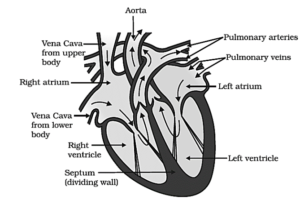
- Human heart is situated in the centre of the thoracic cavity with its lower end tilted towards left.
- It consists of two auricles which receive blood and two ventricles which pump blood to different parts of the body.
- It is covered by a membrane, the pericardium.
- In a median vertical section of the heart, four chambers can be seen very clearly. The heart can be divided into right and left halves. Each half has two chambers.
- The upper chamber is the atrium or auricle and the lower is ventricle.
- Each atrium or auricle opens in its respective ventricle through an opening which is guarded by a valve.
- This valve allows the flow of blood only in one direction i.e., from atrium or auricle to ventricle.
Heart beat:
- The heart beats continuously in a rhythm throughout life without any
- The heart beat occurs due to contraction and relaxation of its atria/auricles and ventricles at an average rate of 72 times per minute.
- The heart beat rate increases during exercise or heavy work.
- The contraction of heart is called systole and its relaxation is called diastole.
- The series of events which occur during one complete beat of the heart is known cardiac cycle.
Cardiac cycle consists of three steps which are: (i) Auricular systole. (ii) Ventricular systole and (iii) Joint diastole.
- Auricular systole : In this first step both auricles contract simultaneously and pass blood into their respective ventricles;
- Ventricular systole : In this step two, both the ventricles contract simultaneously and the blood is forced from left ventricle into the aorta and from right ventricle into pulmonary artery.
- Joint diastole : After this, both auricles and ventricles relax for a very short time. In third step, blood enters the left and right auricles respectively from the pulmonary vein and vena cava.
Ventricles have thicker muscular walls than the auricula or atria because ventricle act as pumping chambers and they have to pump the blood.
Functions of chambers of human heart:
- Left Atrium: This chamber of heart is thin-walled and situated in the upper part of the heart on the left side. The left atrium collects the oxygen rich blood from the lungs and then sends it to the left ventricle.
- Left Ventricle: Left ventricle of the heart has thicker muscular walls. It receives oxygenated blood from left atrium and pumps it to all parts of the body.
- Right atrium : Right atrium receives de-oxygenated blood comes from the body, as it relaxes. As the right atrium contracts, the corresponding lower chamber, the right ventricle, dilates.
- Right Ventricle: It receives de-oxygenated blood from right atrium and pumps it to the lungs for oxygenation.
Transport and exchange of oxygen and carbon dioxide in human heart :
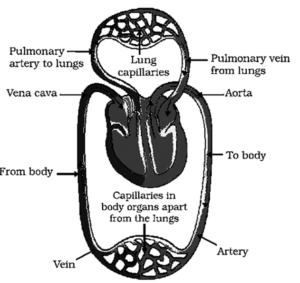
4-chambered heart :
- Bird and mammals need more energy to maintain their body temperature.
- The 4-chambered heart has separation of left side and right side which is useful to these organisms by not allowing mixing of oxygenated and deoxygenated blood.
- This separation allows an efficient supply of oxygen to the body.
3-chambered heart :
- In animals that do not required to use energy to maintain the temperature of body the body temperature depends on the temperature in the environment. Such animals, like amphibians or many reptiles have three-chambered hearts, and tolerate some mixing of the oxygenated and de-oxygenated blood streams.
2-chambered heart :
- Fishes, have only two chambers to their hearts, and the blood is pumped to the gills, is oxygenated there, and passes directly to the rest of the body.
- Thus, blood goes only once through the heart in the fish during one cycle of passage through the body.
Double circulation : Blood goes through the heart twice during each cycle in man, other vertebrates is known as double circulation.
(3) The tubes – blood vessels :
- Arteries are the vessels which carry blood away from the heart to various organs of the body.
- Since the blood emerges from the heart under high pressure, the arteries have thick, elastic walls.
- Veins collect the blood from different organs and bring it back to the heart. They do not need thick walls because the blood is no longer under pressure, instead they have valves that ensure that the blood flows only in one direction.
- On reaching an organ or tissue, the artery divides into smaller and smaller vessels to bring the blood in contact with all the individual cells.
- The smallest vessels have walls which are one-cell thick and are called capillaries. Exchange of material between the blood and surrounding cells takes place across this thin wall.
- The capillaries then join together to form veins that convey the blood away from the organ or tissue.
| Know This :
Blood pressure :
|
Lymphatic system :
Lymphatic system is a circulatory system which permeates entire human body
and transports a fluid called lymph from tissues to blood vascular system. It has following components:
- Lymph
- Lymph capillaries
- Lymph vessels
- Lymph nodes.
Lymph:
- Through the pores present in the walls of blood capillaries, some blood cells like white blood cells, plasma, some proteins and salts escape into intercellular spaces in the tissues. This fluid forms lymph or tissue fluid.
- The lymph is similar to plasma except that it contains very less amount of proteins.
- From intercellular spaces, lymph goes into lymphatic capillaries. Lymphatic capillaries join to form large lymph vessels which finally open into larger veins. Lymph flows only in one direction, that is from tissues to heart through veins.
Functions of lymph :
- Lymph carries digested and absorbed fats from sm all intestine to different tissues of the body.
- It drains excess fluid from extracellular spaces back into the blood.
- Lymph protects tissues/cells from infection,
- It also removes waste products from the body cells and drains them into blood.
Transportation in Plants :
The soil is the nearest and richest source of raw materials like nitrogen, phosphorus
and other minerals for plants.
Components of the transport system in highly organised plants :
Ans. The transport system in highly organised plants consists of two components- xylem and phloem.
- Xylem: It consists of vessels, tracheids, xylem parenchyma and xylem fibres. The interconnected vessels and tracheids form a continuous system of water conducting channels reaching all parts of the plant. Xylem conducts water and dissolved minerals absorbed from the soil.
- Phloem: It consists sieve tubes, companion cells, phloem parenchyma and phloem fibres. The sieve tubes of phloem with the help of companion cells conduct soluble products of photosynthesis from leaves to different parts of the plant. The transportation of materials through phloem is called translocation.
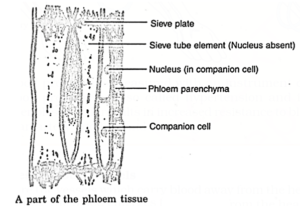
Transportation of water and minerals in plants :
- Water and dissolved minerals are transported through xylem tissue. Xylem vessels and tracheids of roots, stem and leaves are interconnected to form a continuous system of water conducting channels reaching all the parts of the plant.
- The root cells in contact with the soil actively take up ions from the soil. This creates a difference in the concentration of these ions between the root and the soil. Water therefore moves into roots from the soil to eliminate this difference. This results in continuous movement of water into the xylem. It forms a column of water that is steadily pushed upwards.
- There is continuous loss of water through stomata of the leaves in the form of water vapours. This process is called Transpiration creates a suction pressure which pulls water from the xylem cells of root. As a result, there is enhanced absorption and upward movement of water and dissolved minerals from roots to the leaves.
Transportation of food in plants :
- Plants transport products of photosynthesis, amino acids and other substances in soluble form through phloem to storage organs of roots, fruits and seeds and also to growing organs. This transport of different materials in soluble form through phloem is known as translocation.
- Translocation takes place in phloem by sieve tubes with the help of companion cells both in upward and downward directions.
Mechanism of translocation:
- Translocation is an active process and utilizes energy.
- Materials like sucrose is transferred from leaf cells or from the site of storage into phloem tissue.
- This process requires energy which is provided by ATP (adenosine triphosphate) molecules.
- Entry of sucrose into phloem tissue causes increase in osmotic pressure. As a result, water from outside moves into phloem.
- This pressure moves the dissolved materials in the phloem to tissues which have less pressure.
- It allows the phloem to move materials according to plant’s need. For example, in the spring season, sugar stored in the root or stem tissues would be transported to the buds which need energy to grow.
Advantages and Disadvantages of transpiration :
(i) Advantages of transpiration :
- Transpiration is the process by which land plants lose water.
- Plants absorb large amount of water and most of it is transpired by the plant.
- For example, a maize plant loses about 3-4 litres of water per day and a maize field spread over one acre will lose about 85,000 litres of water during its growing season.
- Although, plants lose such a huge amount of water by the process of transpiration even then transpiration helps the plant in many ways.
- It provides a system of transport of water and minerals, cools the plants thus maintaining proper temperature for other physiological activities.
(ii) Disadvantages of transpiration :
- Transpiration also has many disadvantages like reduction in photosynthesis and yield.
- There is also fall in the rate of metabolism.
- Processes like water uptake, cooling of leaves and salt-uptake can occur even without transpiration.
- Transpiration cannot be checked.
- Whenever stomata are open for gaseous exchange (of carbon dioxide and oxygen) stomatal transpiration will always occur.
- Therefore, transpiration is called a necessary or unavoidable evil.
Transportation of water in plants : (i) During day time (ii) At night.
- During day time suction pressure created by transpiration (evaporation of water) helps in the absorption and upward movement of water and minerals dissolved in it from roots to the leaves, up to the top of plant.
- At night, the effect of root pressure (created by movement of water from the soil to the xylem of roots) in transport of water is important.
Need of proper system of transportation in plants :
- Diffusion is a slow process as compared to the need of leaves, roots and other parts of plants.
- If the distances between leaves containing chlorophyll and roots in contact with soil are small, energy and raw materials can easily diffuse to all parts of the plant body. But in plants, such as shrubs and trees, these distances become large.
- Because of the plant body design, diffusion processes will not be sufficient to provide raw materials to leaves and energy to roots.
- Therefore, a proper system of transportation is essential.
Excretion :
Definition : The biological process involved in removal of the excess of water, salts and toxic wastes (like urea and uric acid) from the body is called excretion.
- All organisms must excrete because the metabolic wastes are very toxic and they will be harmful to the body if stored.
- In many unicellular organisms like Amoeba and Paramoecium excretion takes place by diffusion. In these unicellular organisms, elimination of metabolic wastes takes place by diffusion from the body surface into the surrounding water.
- Complex multi-cellular organisms use specialised organs to perform the excretion.
Excretion in Human Beings :
- The excretory system of man is responsible for the excretion of nitrogenous wastes.
- It consists of: (a) a pair of kidneys, (b) two ureters and (c) a urinary bladder and (d) a urethra.
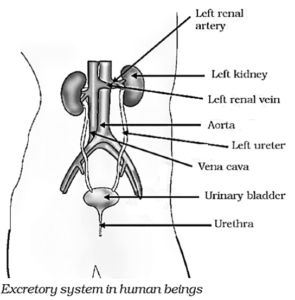
- Kidneys are bean-shaped and are located in the abdominal region on either sides of vertebral column.
- From each kidney a tubular structure emerges which is called ureter.
- The ureter travels downwards and open in a sac like structure called urinary bladder, which stores urine.
- Besides the two openings of ureters in this bladder it has another opening which opens in the urethra.
- Urethra forms the passage of urine and opens outside.
Three vital functions of human kidneys :
- Kidneys act as an excretory organ in human body to remove toxic wastes from the body.
- Kidneys also maintain the concentration of water and mineral ions in the body.
- It regulates blood pressure by controlling the fluid balance in the body.
Structure and functioning of nephrons :
Structure of Nephron:
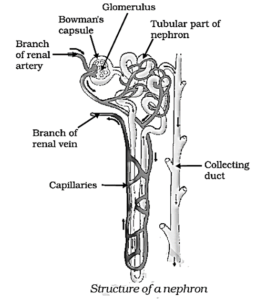
- Nephron is the filtration unit of kidney.
- It consists of a tubule which is connected with collecting duct at one end and a cup-shaped structure at the other end.
- This cup-shaped structure is called Bowman’s capsule.
- Every Bowman’s Capsule contains a cluster of capillaries, called Glomerulus.
- The blood enters into glomerulus through afferent arteriole of renal artery and leaves it through efferent arteriole.
(i) Functioning of nephron: Filtration of blood takes place in Bowman’s capsule from the capillaries of glomerulus. The filtrate passes into the tubular part of the nephron. This filtrate contains glucose, amino acids, urea, uric acid, salts and a major amount of water.
(ii) Reabsorption:
- As the filtrate flows along the tubule, useful substances such as glucose, amino acids, salts and water are selectively reabsorbed into the blood by capillaries surrounding the nephron tubule.
- The amount of water reabsorbed depends on the need of the body and also on the amount of wastes to be excreted.
- The filtrate which remained after reabsorption is called urine.
- Urine contains dissolved nitrogenous wastes i.e., urea and uric acid, excess salts and water. Urine is collected from nephrons by the collecting duct to carry it to the ureter.
Functions of renal artery, kidney, ureter and urinary bladder :
- Renal Artery: Afferent arteriole of renal artery supplies blood containing body wastes to glomerulus for filteration.
- Kidney produces urine.
- Ureter passes the urine from kidney to urinary bladder.
- Urinary bladder stores the urine until the pressure of the expanded bladder leads to the urge to pass it out through the urethra.
Osmoregulation : Kidneys While removing wastes from the blood also regulates its composition (i.e., percentage of Water and salts). This is called Osmoregulation.
Common ions derived from food which are excreted in urine are sodium, potassium, magnesium, calcium, chlorides, phosphates, sulphates and oxalates. The movement of these ions help to maintain acid-base balance of body and keeps pH of arterial blood at 7.4.
Urine regulation :
The amount of urine produced depends on the amount of Water reabsorbed which in turn depends on
- amount of water present in the body.
- amount of nitrogenous wastes present in the body.
The amount of urine produced is regulated by certain hormones like Antidiuretic
hormone (ADH) or vassopressin hormone of the posterior lobe of master gland (pituitary) of the body which controls the movement of water and Na+ ions into and out of the nephrons.
Kidney failure :
- Kidney failure leads to accumulation of toxic nitrogenous wastes like urea and uric acid in the body. This can even lead to death.
- Causes of kidney failure are infections, injury or restricted blood flow to kidneys.
Dialysis : Dialysis is a process used in artificial kidney (hemodialysis) or dialysis machine to remove nitrogenous wastes from the body. It is the process of selectively filtering out nitrogenous wastes and retaining larger molecules such as proteins and other useful components of the blood.
Artificial kidneys (Hemodialysis):
- Artificial kidneys consist of a number of tubes with semi-permeable lining (selectively permeable membrane).
- These tubes are suspended in a tank filled with dialyzing fluid.
- The dialysing fluid has the same concentration as blood plasma but it does not contain nitrogenous wastes.
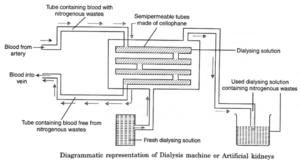
Working:
- The blood of the patient is passed through dialysing tubes.
- As blood passes through tubes, the waste products (e.g., urea, ammonia, etc.) from the blood pass into dialyzing fluid by diffusion.
- The purified blood is pumped back into the patient.
- Artificial kidney does filtration but no reabsorption, as is done by kidney.
- Dialysis solution containing nitrogen wastes is changed from time to time.
Excretion in plants:
Plants use completely different strategies for excretion than those of animals. Oxygen itself can be thought of as a waste product generated during photosynthesis
- Oxygen is eliminated mainly through stomata during the day by diffusion.
- They get rid of excess water by transpiration.
- Waste products which are stored in leaves are excreted with the fall of these leaves.
- Many plant waste products are stored in cellular vacuoles.
- Some waste products are stored as resins and gums, especially in mature xylem.
- Plants also excrete some waste substances into the soil around them.
Click on below links to get PDF from store
PDF : Class 10th-Science-Chapter-5-Life Processes-Notes
PDF : Class 10th-Science-Chapter-5-Life Processes-Solution
Main Page : NCERT-Class-10-Science – All chapters notes, solutions, videos, test, pdf.
Previous Chapter : Chapter-4- Carbon and its Compounds – Online Notes
Next Chapter : Chapter-6- Control and Coordination – Online Notes
We reply to valid query.